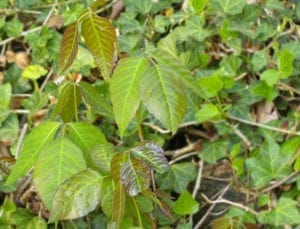
Poison Ivy
As I sat at my desk trying to ignore the itchy poison ivy blisters on my legs and feet, I started to think about what other “hazardous materials” I may encounter out in the wilderness. I decided to do a little research and found that there are a number of safety hazards that Mother Nature has provided.
I started with the cause of my current itching…urushiol. Urushiol is a highly irritating oil found in poison ivy, poison oak and poison sumac. The oil is present in all parts of the plants, including the leaves, stems, flowers, berries, and roots. Despite the common names of the plants, urushiol is not a poison but an allergen, and because of this it will not affect certain people. Because urushiol is inside the plant, brushing against an intact plant will not cause a reaction. But undamaged plants are rare because poison oak, ivy and sumac are very fragile plants. Stems or leaves broken by the wind, animals, and even tiny holes made by insects can release urushiol. The first symptom of reaction is a severe itching of the skin. Later, a red inflammation and a blistering of the skin occurs. In more severe cases, oozing sores develop. Indirect contact with urushiol can also cause the rash. This may happen when you touch clothing, pet fur, sporting gear, gardening tools, or other objects that have come in contact with one of the plants.
Giant hogweed has been in the news quite a bit recently. According to the NY State DEC, giant hogweed is a biennial or perennial herb in the carrot family (Apiaceae) which can grow to 12 feet or more. Its hollow, ridged stems grow 2-4 inches in diameter and have dark reddish-purple blotches. Its large compound leaves can grow up to 5 feet wide. Its white flower heads can grow up to 2 1/2 feet in diameter. When giant hogweed sap, which contains photosensitizing furanocoumarins, contacts human skin in conjunction with sunlight, it can cause phytophotodermatitis – a serious skin inflammation. In brief, the sap prevents your skin from protecting itself from sunlight which leads to a very bad sunburn. Heat and moisture (sweat or dew) can worsen the skin reaction. The phototoxic reaction can begin as soon as 15 minutes after contact, with sensitivity peak between 30 minutes and two hours after contact. If the sap gets into the eye, permanent blindness can occur. Sap can be located in all parts of the plant but higher concentrations are found in the lower part of the hollow stems and petioles; the hollow hairs on the plant; the foliage, stem, flower, or fruit (seed).
Atropa belladonna, also known as deadly nightshade, is a plant I had only read about in fiction. In my research, I found the website for Belladonna Killz, which had a ton of interesting information about this ancient plant. Belladonna is known for its toxicity. It is one of the most poisonous plant species found in the Western hemisphere. All parts of the belladonna plant are toxic. In fact, belladonna berries are greatest danger to children as it looks very attractive and somewhat taste sweet. All parts of the plant are poisonous containing tropane alkaloids. The active agents in belladonna, atropine, hyoscine and hyoscyamine have anticholinergic properties. Consumption of two to five berries by children and ten to twenty berries by adult can be fatal. Even the ingestion of a leaf can be lethal to an adult. The information on toxicity of atropa belladonna also reveals that the most toxic part of the belladonna is the root of the plant, though this can vary from one specimen to another. The symptoms of belladonna poisoning include fever, hallucination, dilation of pupils, headache, flushed skin, nausea, loss of balance, dry throat, urinary detention, convulsions, and delirium. Other symptoms can be complete dryness of skin. However, fatal cases have a rapid pulse that turns feeble. The antidote is physostigmine or pilocarpine, the same as for atropine. Information on belladonna toxicity further reveals that the deadly symptoms of belladonna are caused by atropine’s effect and disruption of the parasympathetic nervous system’s ability to regulate non-volitional/subconscious activities such as sweating, breathing, and heart rate. Toxicity of belladonna plant information also reveals that this plant is also toxic to many domestic animals and livestock. Belladonna poisoning can caused narcosis and paralysis to animals. However, cattle and rabbits eat the plant seemingly without suffering harmful effects.
Stinging nettle is another natural hazard that I have had the unfortunate opportunity to become acquainted with. While not as dangerous as the previous examples, it is not something that I would choose to come in contact with a second time. The leaves and stems of the stinging nettle plant are very hairy with both non-stinging hairs and many stinging hairs (trichomes), whose tips come off when touched. This transforms the hair into a needle that will inject several chemicals, such as acetylcholine, histamine, 5-HT or serotonin, and possibly formic acid. This mixture of chemical compounds cause a painful sting or paresthesia from which the species derives its common name, as well as the colloquial names burn nettle, burn weed, burn hazel. Despite the hazard, stinging nettle is still commonly used as a source of food as well as for medicinal purposes.
The best way to avoid exposure to any of these plants is through education. If you are going to be spending time outdoors, especially in unfamiliar areas, make sure you are aware of what hazardous plants are found in that area. Make sure that you know how to identify and avoid them, as well as what to do if you are exposed.

Atropa belladonna or Deadly Nightshade






I’ve been wondering what this vine is growing up my backyard fence. It is enjoyable to watch the colorful changes from flowers to berries. Several robins were picking at the red berries this morning. It looks like they were eating the berries. Toxic?
There are many different types of vines/berries that may be toxic to humans, but non-toxic to other wildlife. If you’re really curious, you should consult a local wildlife expert.